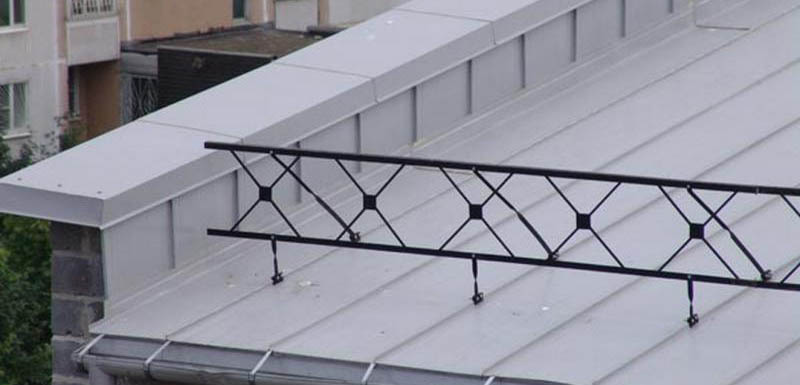A parapet roof is a part of a roof that eliminates the danger of a flat roof while opening up a wealth of opportunities to use roof space safely and effectively.
A parapet roof is, simply put, when a building’s outermost walls extend upwards past the roof around the edges, most often by a few feet.
While a roof parapet wall may seem like a small detail in the grand scheme of the entire building design, it can actually change the dynamic of an entire roof, both in terms of cosmetic detailing and safety.
When choosing a parapet, it’s important to keep in mind the different options there are to choose from.
Parapets have been used for various purposes throughout history, and while nowadays certain kinds of parapets have outlived their original use, they’re still available to choose from if a buyer is more inclined to what are now purely cosmetic differences.
- The most common type of parapet seen nowadays is the “plain parapet,” which is simply a basic, flat wall extension. Some plain parapets come with an added coping or corbel to help bear structural load, but most of them are simply flat extensions of the wall below the roof.
- An “embattled parapet” is an older kind of parapet which isn’t really used today in modern buildings, but can still be seen in many older buildings. “Embattled parapets” were initially designed for castles, with little openings and alternating high-and-low parts at the top of the wall for archers and other soldiers to protect a property in the case of a siege. Now that the defensive detailing is unnecessary, owners rarely ever go for this style of parapet wall unless commissioning a building with a historical look (say, for a film shoot).
- “Paneled parapets” are also an older kind of parapet, and are similar to the plain parapet with the added detail of ornamental panels facing outwards on display. This was done most often at different points in the Gothic period of English architecture, and was purely a cosmetic detail requested by rich patrons.
- “Perforated parapets” are a kind of parapet design that has origins in older time periods but is still used today. Perforated parapets are a lot more artistic than the plain parapet, and employ a pattern of holes and perforations that evoke a certain kind of aesthetic feel and can really pull a building together, even in modern times.
How Parapets are Utilized
Looking at a building from the ground, a parapet may seem to simply be a design choice that adds little more than a characteristic look to a building. However, these days parapets add a lot more to a flat roof than just a cosmetic detail.
- Safety: Adding a parapet wall makes a flat roof far safer than leaving the roof’s edge exposed. If a building has roof access that residents use regularly for whatever reason, adding a parapet greatly decreases the chance that someone could fall over the edge and injure themselves. It also makes the space safer to build other additions to the roof, which opens up a world of opportunities to make further use of the space.
- Utilizing space: By simply extending the walls above the roof and making the space safer, the roof is opened up to a number of uses. Depending on the weather in the area, a greenhouse may be a scenic addition to the roof, or a lounge area for recreational use. Depending on what’s already up there, it may just make the maintenance of preexisting structures safer, or allow for the addition of structures and fixtures to the roof with the added safety of knowing they’ll be secure on the roof (like a rainwater collector or a satellite dish).
With the addition of a parapet, a roof can be used in a large number of ways. However, there are a few things to consider before deciding to install a parapet to a building’s roof.
When designing a house, planning it out so as to extend the walls past the roof is a simple job.
However, when planning on adding a parapet to an existing roof, there are some factors to consider when making the decision.

Things to Consider
Before deciding to add a parapet to a roof, there are a few factors and details to keep in mind when undertaking such a large endeavor:
- Time: Extending a preexisting wall up past a roof after a building has already been finished is a far more difficult undertaking than building one alongside the building to begin with. If the parapet needs to be added after the building is already complete, then construction could be a lengthy process. This can cause noise and disturbance for quite some time before the parapet is actually finished. It would also harshly limit access to whatever is already on the roof.
- Access: For an empty roof this isn’t a big deal; but if there are satellite dishes and meters and such on the roof, construction could damage these fixtures, or severely restrict access to them during the construction process. It’s important to consider the preexisting features of a roof before deciding to add anything else to the mix, and consider what the endeavor might get in the way of.
- Cost: While adding a parapet is a must as a first step in a roof development plan, if it’s also the last step, there isn’t much of a point in sinking money into it as a project. While a parapet adds both safety and utility of a roof, if the roof goes unused at all times, or if there’s no access to the roof save for maintenance workers, there isn’t really any point to spending money on the parapet unless there’s a desire to add it as a cosmetic detail.
